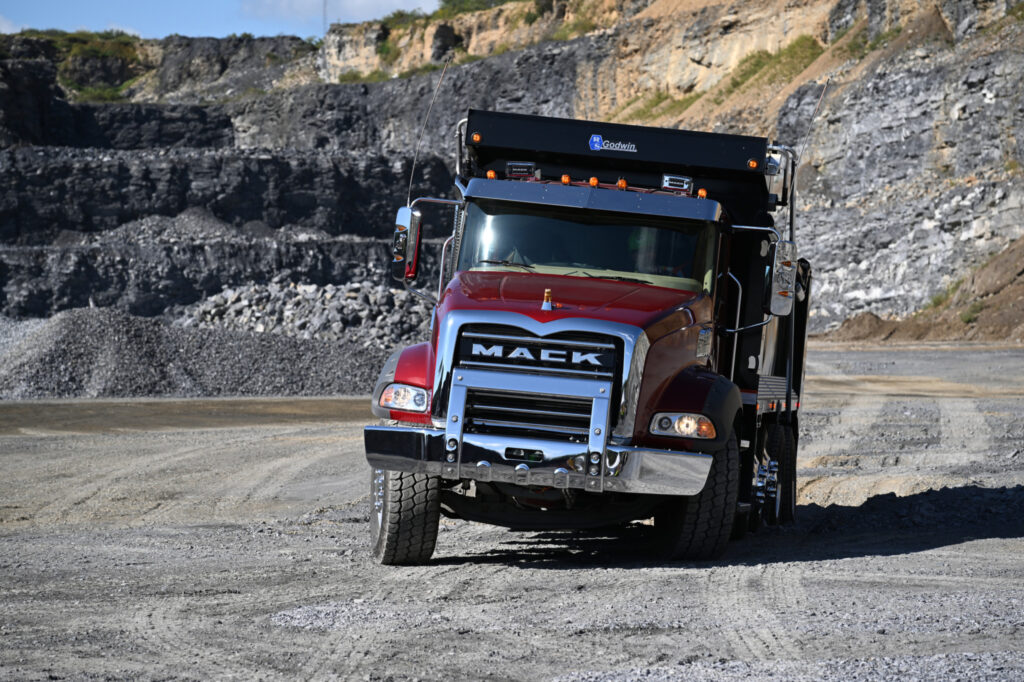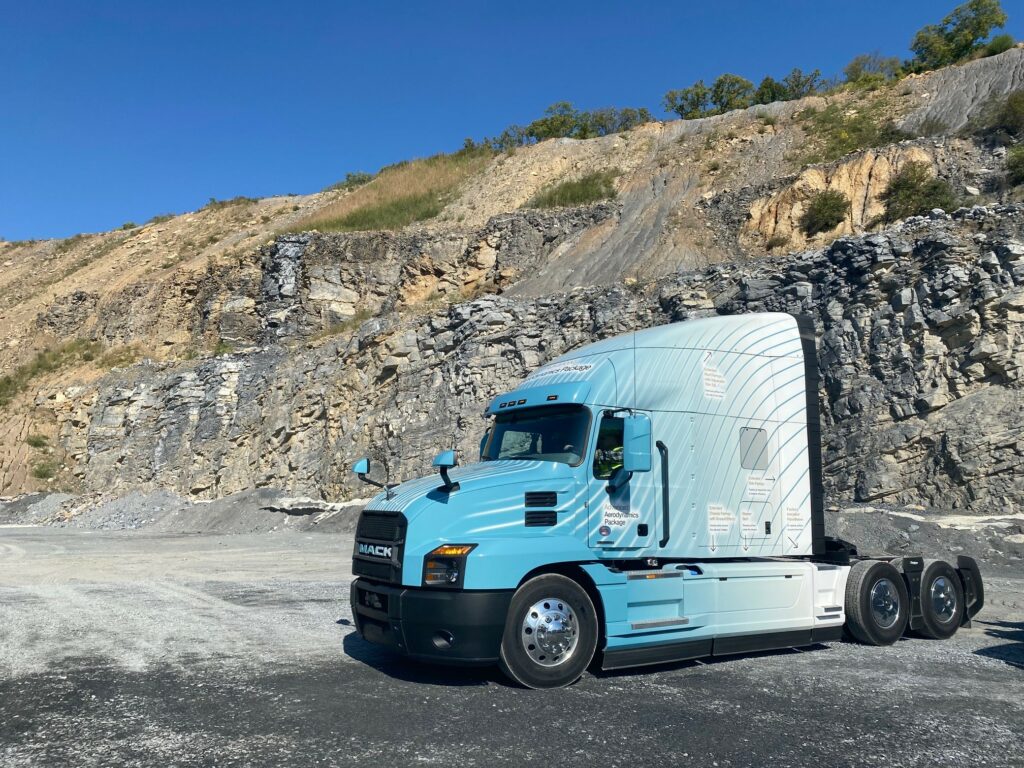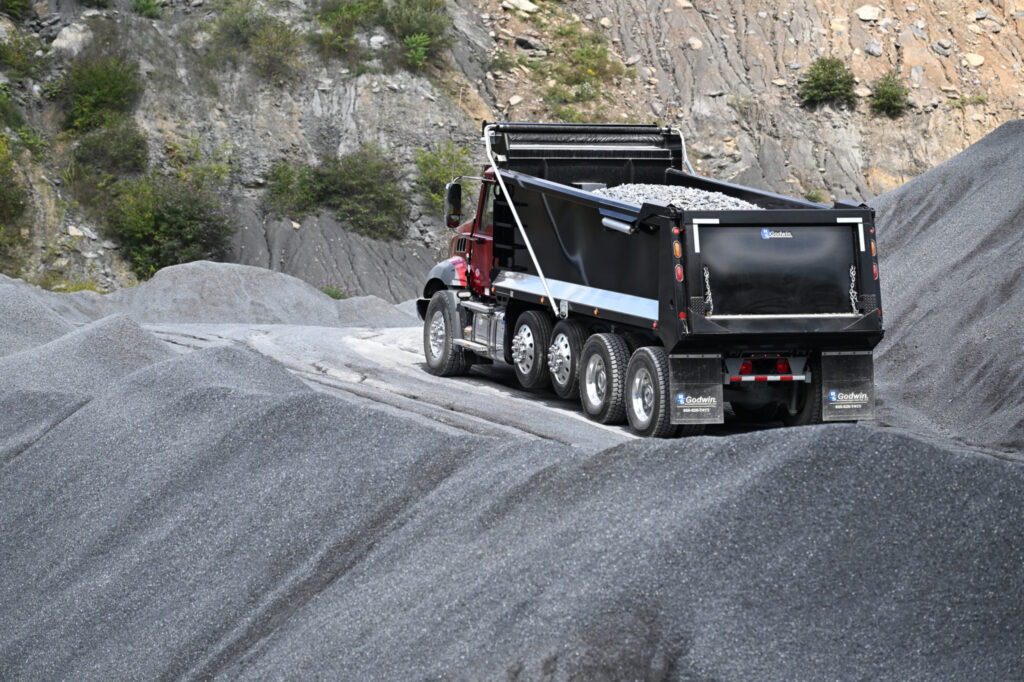Mack’s Command Steer puts driver back in control
Hauling heavy aggregate loads over rough roads – or no roads at all – can leave a driver feeling like they’ve spent their day in a cage fight with the steering wheel as their opponent. But Mack Trucks’ Command Steer variable steering technology makes the job a lot easier, detecting wheel inputs not coming from the steering wheel and helping the driver overcome them with a lot less physical effort.
The end result, says Mack, is a less-fatigued driver at the end of a shift. Command Steer also helps improve driver productivity and safety. And the benefits of the technology translate well to on-highway applications where different scenarios produce the same types of challenges for drivers.
Launched in 2021, Mack finally had the chance to invite editors to experience Command Steer first-hand this week, at H&K’s sprawling Easton, Penn., limestone quarry.

How it works
Command Steer shouldn’t be confused with lane keeping assist. It doesn’t involve cameras that seek out lane markings and actively keep a truck centered in the lane, nor will you find lane markings in a quarry like the 250-foot-deep limestone pit where we were driving.
What it does do is drastically lessen the force the driver must put into the steering wheel when turning or negotiating rough terrain. Sensors throughout the truck monitor more than 2,000 inputs a second, including driver and environmental inputs, such as potholes or bumps in the road.
An electric steering motor mounted to the steering gear can provide up to 11 Nm of torque assist into the steering shaft to smooth out harsher inputs. What does 11 Nm equate to? About 10.7 lb. of assistance, according to Tim Wrinkle, senior product manager – vocational and medium-duty trucks with Mack.
Put another way, driver effort is reduced by up to 85%, which studies have shown reduces fatigue by 30% over the course of a workday. Command Steer knows when to help out based on the driver’s steering wheel angle compared to harsh wheel inputs from environmental factors. Basically, it knows what the driver’s intentions are, as well as how the road itself is opposing those intentions, and comes to the driver’s aid.
“If the wheel senses a large force such as a pothole or a log, it’s going to put a huge force onto the front wheel,” Wrinkle explained. “If there’s no steering angle change from the driver, it will compensate [for] that force and keep the truck going straight.”
Benefits for drivers
Situations in which the driver will benefit include navigating rough roads and precision steering at low speeds including backing maneuvers. I encountered a range of these conditions in the H&K quarry, beginning with a slalom course that required aggressive steering to navigate. The Mack Granite with Command Steer was noticeably easier to steer through the pilons than a similar truck – both loaded with 20 tons of aggregate – that didn’t have Command Steer. That was over a relatively smooth gravel surface.
Next up were some massive potholes. I was jostled around in both trucks, but the one with Command Steer kept its course even when I took my hands of the wheel. There was no wrestling with the steering wheel to keep the truck running straight as there was in the Granite without Command Steer.
Another nice feature is “return to zero.” The steering wheel immediately spun back to its centered position when I removed my hands.

Available on-highway
A couple Mack Anthem highway tractors were also available to test the technology, as it is offered in on-highway applications as well. You won’t often find an Anthem in these types of conditions, but the benefits are still there on-highway – even if it’s under different circumstances.
At higher highway speeds, it’s more than a driver comfort feature – it’s also capable of improving safety. Think of the effort it takes to steer a truck down a highway with strong crosswinds buffeting the side of a 53-foot trailer. Command Steer will take out a lot of the effort the driver has to put into reacting to those crosswinds.
And sudden inputs — such as dropping a tire onto the gravel shoulder of a paved road, blowing a steer tire, or hitting a pothole – are also smoothed out so the driver is less likely to lose control of the vehicle.
It will even help when driving on a highway with tire grooves in the road surface, pointed out Stu Russoli, highway product manager with Mack Trucks.
“We are extremely successful with fuel haulers,” he added, noting they have to maintain precise control of their trucks while transporting fuel to busy gas stations. “They want to put Command Steer on everything. To be able to just barely touch the steering wheel and move around is very important.”
Responsive to light steering wheel inputs
Back at the H&K quarry, the Anthems were extremely responsive to light steering wheel inputs offering nearly effortless precision steering. At higher speeds, the steering tightens up to offer that more familiar feel. Basically, there’s no longer any need to fight the steering wheel all day. It’s intuitive, constantly alert and there to help in an instant.
Jonathan Randall, senior vice-president of Mack sales and communications operations, said the company sees it as a valuable driver recruitment and retention tool for fleets that are struggling to find and keep drivers.
“The reality is, getting truck drivers in the cab and keeping truck drivers in the cab remains a challenge for all operators regardless of the segment they’re in,” he said. Command Steer helps in three ways, improving: driver comfort; productivity; and fatigue, he added, equating Command Steer to the advent of power steering.
Command Steer is available for order now on the Mack Granite and Anthem.

Have your say
This is a moderated forum. Comments will no longer be published unless they are accompanied by a first and last name and a verifiable email address. (Today's Trucking will not publish or share the email address.) Profane language and content deemed to be libelous, racist, or threatening in nature will not be published under any circumstances.